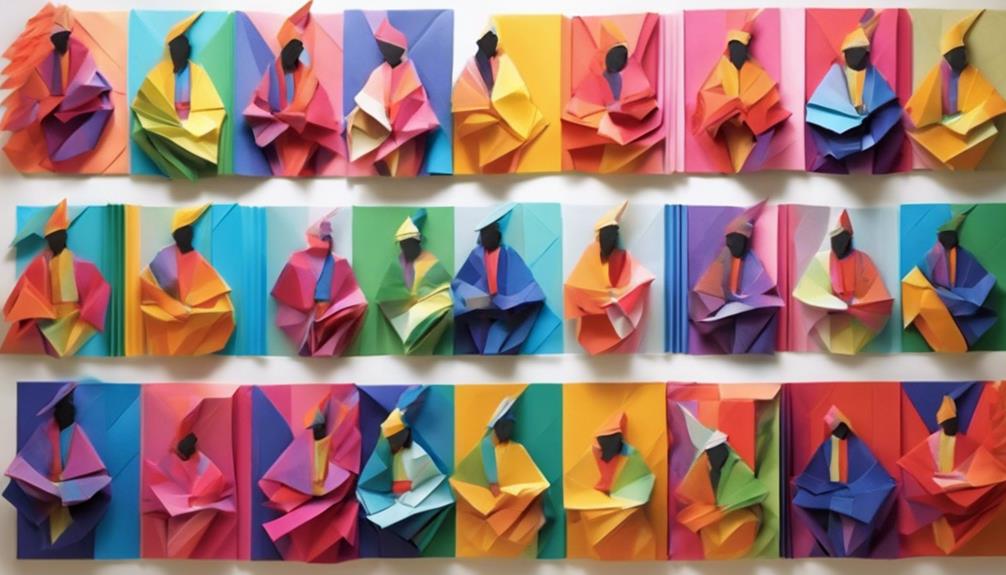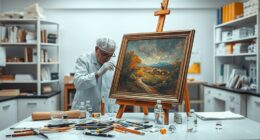Ten iconic avant-garde artworks challenged artistic norms profoundly. Gustave Courbet's 'The Painter's Studio' redefined the conventional art space. Manet's 'Le Déjeuner Sur L'herbe' juxtaposed nudity and daily life, spurring debate. Monet's 'Impression, Sunrise' birthed Impressionism, capturing transient moments. Picasso's 'The Three Musicians' fragmented figures, shattering traditional forms. Malevich's 'Black Square' rejected representational art in favor of Suprematism. 'Theater Piece No. 1' featured nude models covered in Klein's blue paint, pushing boundaries. 'Imagen De Yagul' blended Mexican folk art with modernism. 'Bauhaus Stairway' integrated art and design with Bauhaus principles. Avant-garde art broke all rules, innovating and experimenting.
Key Takeaways
- Manet's 'Le Déjeuner Sur L'herbe' juxtaposed nudity with everyday life, challenging conventions.
- Picasso's 'The Three Musicians' shattered traditional forms with fragmented figures.
- Monet's 'Impression, Sunrise' birthed Impressionism by capturing fleeting moments.
- Malevich's 'Black Square' rejected representational art in pioneering Suprematism.
- Dalí's 'The Persistence of Memory' challenged perceptions with surrealism and dream-like imagery.
The Painters Studio
Gustave Courbet's painting 'The Painter's Studio' challenged artistic conventions with its depiction of the artist surrounded by a diverse cast of characters. This iconic work symbolizes the democratization of art and the avant-garde movement's defiance of traditional standards.
The Paris Salon, a prestigious art exhibition, was known for upholding strict artistic norms. However, Courbet's piece boldly asserted his artistic autonomy by rejecting these academic restrictions and societal norms.
Through 'The Painter's Studio,' Courbet not only defied the established artistic hierarchies but also emphasized the importance of individual expression and social engagement in the avant-garde. By merging radical social and artistic progressiveness, Courbet paved the way for a new era in art, where creativity paradigms were redefined.
This masterpiece embodies the avant-garde spirit, challenging the status quo and pushing boundaries to create a more inclusive and expressive artistic landscape.
Le Déjeuner Sur L'herbe

Manet's 'Le Déjeuner Sur L'herbe' stunned audiences by portraying a nude woman picnicking with clothed men, challenging traditional artistic norms.
This avant-garde masterpiece by Édouard Manet pushed the boundaries of acceptability with its bold depiction of nudity in a contemporary setting. The composition of the painting, with its stark contrast between the nude woman and the fully clothed men, sparked intense debates about morality and artistic freedom.
Manet's innovative use of lighting and arrangement revolutionized the representation of nudes in art, ushering in a new era of modern art.
'Le Déjeuner Sur L'herbe' not only defied traditional norms but also played a pivotal role in the development of avant-garde movements by breaking away from academic conventions. This controversial artwork remains a reflection of Manet's daring approach and his commitment to pushing the boundaries of artistic expression.
Impression, Sunrise

Claude Monet's 'Impression, Sunrise' marked a significant shift in artistic innovation with its loose brushwork and vibrant color palette. This painting, exhibited in 1874, played a pivotal role in the emergence of Impressionism as a revolutionary art movement.
Its impact on the art world emphasized capturing fleeting moments and subjective impressions, challenging traditional notions of realism and paving the way for modern artistic expression.
Artistic Innovation in Impressionism
The artistic revolution sparked by Impression, Sunrise challenged traditional norms with its unique portrayal of light and fleeting moments. Claude Monet's groundbreaking painting, exhibited in 1874, marked the onset of Impressionism, a movement characterized by its innovative approach to art conventions.
Depicting a hazy harbor sunrise with loose brushwork and a focus on light, Impression, Sunrise symbolized a departure from academic realism, ushering in a new era in art history. This shift towards capturing fleeting moments and atmospheric effects was a significant departure from the established norms of the time.
The title 'Impressionism' itself stemmed from a critic's derogatory comment on this very painting, highlighting the impact it had on the art world. Monet's daring departure from traditional techniques in Impression, Sunrise set the stage for a wave of artistic experimentation and paved the way for the Impressionist movement to flourish.
Impact on Art World
Impact on the art world was profound following the debut of 'Impression, Sunrise' by Claude Monet in 1874, as it challenged traditional norms and sparked a new era of artistic experimentation. This avant-garde artwork had a significant impact on modern art, inspiring artists to break away from conventional techniques and embrace more innovative and unconventional styles. 'Impression, Sunrise' played a pivotal role in the development of avant-garde movements by encouraging subjective interpretations and pushing the boundaries of what art could be.
| Impact on Art World | |
|---|---|
| Key Points | Description |
| Challenging Norms | Monet's unconventional approach in 'Impression, Sunrise' challenged established norms. |
| Subjective Interpretations | The painting encouraged artists to focus on subjective interpretations of reality. |
| Innovative Artists | Monet's work inspired a generation of artists to experiment with new artistic techniques. |
| Avant-Garde Movements | 'Impression, Sunrise' paved the way for avant-garde movements in the art world. |
| Unconventional Style | The loose brushwork and emphasis on light in the artwork introduced a new style in art. |
The Three Musicians

Painted in 1921, Pablo Picasso's 'The Three Musicians' is a seminal Cubist artwork that showcases distinct geometric styles characteristic of the avant-garde movement.
In this revolutionary piece, Picasso portrays three musicians using angular shapes and fragmented forms, a hallmark of Cubism.
The painting defies traditional artistic conventions by reimagining space and form in a way that challenges viewers to perceive the world differently.
'The Three Musicians' exemplifies Picasso's innovative approach to artistic expression, pushing boundaries and sparking conversations about the nature of art.
Black Square

Created by Kazimir Malevich in 1915, 'Black Square' stands as a pioneering work of avant-garde art. Malevich, a key figure in the Suprematism movement, used this piece to challenge traditional constraints in art by embracing pure abstraction. The painting, featuring a simple black square on a white background, symbolizes a departure from representational art towards a new artistic consciousness. Malevich considered 'Black Square' to be the 'zero of form,' representing a starting point for a revolutionary approach to artistic expression.
This iconic artwork not only defied conventional artistic norms but also laid the foundation for abstract art. By eliminating any semblance of recognizable imagery, Malevich pushed the boundaries of artistic interpretation, inviting viewers to engage with the artwork on a different level.
'Black Square' remains a manifestation of Malevich's avant-garde vision and his relentless pursuit of artistic innovation.
Cut With a Kitchen Knife Dada

In 1919, German artist Hannah Höch crafted 'Cut With a Kitchen Knife Dada,' a groundbreaking photomontage challenging traditional artistic norms. This avant-garde piece by Höch is a prime example of Dada art, known for its subversive and experimental nature. The artwork combines elements from various sources in a chaotic composition that reflects the tumultuous post-WWI era. Within 'Cut With a Kitchen Knife Dada,' viewers can find elements of political satire and feminist themes, as Höch critiques societal norms, gender roles, and the political climate of the time.
| Avant-Garde | Photomontage | Dada |
|---|---|---|
| Political satire | Feminist themes | Chaotic composition |
Höch's work challenges traditional artistic conventions, inviting viewers to reconsider established norms. By blending images in a disruptive manner, 'Cut With a Kitchen Knife Dada' embodies the spirit of the Dada movement, pushing boundaries and provoking thought.
Number 1

Manet's 'Le Déjeuner sur l'herbe' disrupted traditional artistic norms by presenting a bold juxtaposition of a nude woman and clothed men in a modern setting.
This avant-garde masterpiece challenged societal expectations and sparked conversations about the boundaries of art.
Iconoclastic Artistic Vision
Challenging societal norms and artistic conventions, 'Le Déjeuner sur l'herbe' by Édouard Manet boldly confronts traditional expectations with its provocative composition. This avant-garde masterpiece revolutionized the art world with its iconoclastic vision, daringly portraying a nude woman among clothed men in a modern setting.
Here are four key points about this controversial work:
- The bold composition of 'Le Déjeuner sur l'herbe' challenged norms by juxtaposing nudity and everyday life, defying conventional standards of morality in art.
- Manet's artistic vision in this seminal piece marked a significant shift towards modernity, influencing future avant-garde movements with its innovative approach.
- The controversial nature of the painting sparked heated debates, highlighting the artist's willingness to push boundaries and provoke societal sensibilities.
- By daring to break away from traditional artistic conventions, Manet's 'Le Déjeuner sur l'herbe' stands as a pioneering example of iconoclastic art that continues to captivate and challenge audiences.
Boundaries Pushed Beyond
Pushing boundaries beyond societal norms, 'Le Déjeuner sur l'herbe' by Édouard Manet boldly confronted traditional expectations with its provocative composition. This avant-garde movement saw artists challenging norms, creating revolutionary works that pushed the boundaries of conventional art.
Claude Monet's 'Impression, Sunrise' shifted the focus to capturing fleeting moments of light and atmosphere, birthing Impressionism. Pablo Picasso's 'Les Demoiselles d'Avignon' shattered traditional forms with its fragmented figures, giving rise to Cubism.
Kazimir Malevich's 'Black Square' rejected representational art, embracing pure abstraction in the iconic work of Suprematism. Salvador Dalí's 'The Persistence of Memory' showcased surrealism, challenging perceptions of time and reality with its melting clocks. These artists were at the forefront of unconventional and innovative movements, daring to challenge the status quo and redefine the art world's boundaries with their groundbreaking works.
Theater Piece No. 1

Yves Klein's pioneering creation in 1960, 'Theater Piece No. 1', revolutionized performance art with its avant-garde exploration of the human form and artistic boundaries. This avant-garde piece by Klein challenged traditional norms with its unique approach:
- Innovative Concept: 'Theater Piece No. 1' involved nude models covered in Klein's distinctive blue paint, blurring the lines between art and life.
- Boundary Breaking: Klein's concept aimed to challenge conventional boundaries of art and the human form, pushing the limits of artistic expression.
- Audience Participation: The performance invited audience engagement, encouraging viewers to interact with the unconventional presentation of the human body.
- Avant-Garde Legacy: This groundbreaking moment in avant-garde art history showcased how artists like Yves Klein sought to break away from traditional rules, leaving a lasting impact on the art world.
'Theater Piece No. 1' remains a significant example of how avant-garde artists pushed the boundaries of artistic expression and audience engagement, paving the way for future unconventional artistic endeavors.
Imagen De Yagul

'Imagen De Yagul' by Rufino Tamayo is a groundbreaking artwork that challenges traditional artistic norms through its unique blend of Mexican folk art and modernist abstraction.
The piece showcases Tamayo's bold use of colors, geometric shapes, and indigenous motifs, illustrating his innovative approach to merging traditional Mexican art with avant-garde principles.
Symbolism in Imagen
Challenging traditional artistic conventions, Rufino Tamayo's Imagen De Yagul embodies a symbolic depth that transcends mere visual representation.
Blend of Mexican Heritage and Modern Abstraction: Imagen De Yagul merges elements of Tamayo's Mexican roots with avant-garde techniques, creating a unique artistic fusion.
Innovative Use of Colors, Shapes, and Symbols: Tamayo's artwork features a sophisticated interplay of bold colors, abstract shapes, and intricate symbols, showcasing his avant-garde approach to art.
Defiance of Traditional Boundaries: Through the use of vibrant hues and unconventional forms, Imagen De Yagul challenges established artistic norms, demonstrating Tamayo's pioneering spirit.
Symbolic Richness and Visual Complexity: Imagen De Yagul goes beyond surface aesthetics, offering viewers a profound exploration of symbolism and visual intricacy that characterizes Tamayo's avant-garde style.
In Imagen De Yagul, Tamayo's masterful combination of symbolism, Mexican heritage, modern abstraction, colors, shapes, and symbols elevates the artwork to a pivotal position within the avant-garde movement, reshaping artistic expression and pushing the boundaries of traditional artistry.
Artistic Techniques Used
Utilizing a photomontage technique, Imagen De Yagul intricately merges multiple images to create a cohesive and visually engaging composition. This avant-garde artwork, created by Manuel and Lola ngel Frade, challenges traditional artistic norms by presenting a surreal juxtaposition of elements like a pre-Columbian sculpture and a modern car.
The photomontage technique employed in Imagen de Yagul allows for a unique and thought-provoking visual experience, inviting viewers to explore the Frade siblings' innovative approach to storytelling through art.
Bauhaus Stairway

Oskar Schlemmer's creation of the 'Bauhaus Stairway' in 1932 exemplifies the innovative fusion of art, design, and performance within the avant-garde movement. This iconic artwork, a demonstration of Schlemmer's ingenuity, captures the essence of the Bauhaus philosophy through its unique blend of geometric forms and theatrical elements.
Here are four key aspects that define the significance of the 'Bauhaus Stairway':
- Avant-Garde Artwork: The 'Bauhaus Stairway' stands out as a prime example of avant-garde art, pushing boundaries and challenging traditional artistic norms.
- Integration of Art and Design: Schlemmer seamlessly integrates art and design in this piece, showcasing the Bauhaus school's emphasis on the intersection of creativity and functionality.
- Emphasis on Performance: Through this artwork, Schlemmer highlights the importance of performance art, adding a dynamic and interactive dimension to the visual experience.
- Reflecting Bauhaus Philosophy: The 'Bauhaus Stairway' embodies the Bauhaus movement's core principles, emphasizing the harmonious combination of art, craft, and technology in a modern context.
Frequently Asked Questions
What Artists Broke the Rules of Art?
Various artists broke the rules of art by challenging conventions and norms. For instance, Édouard Manet depicted a nude woman in a modern setting in 'Le Déjeuner sur l'herbe.'
Pablo Picasso defied tradition with Cubist works like 'The Three Musicians,' using multiple perspectives and abstract forms.
Kazimir Malevich rejected representational art with 'Black Square,' a radical piece of Suprematism.
These artists dared to defy societal expectations, paving the way for new artistic standards.
What Is the Ultimate Example of Avant-Garde?
The ultimate example of avant-garde art is subjective and can vary based on individual interpretations and preferences.
Avant-garde art encompasses a wide range of innovative and unconventional works that challenge traditional norms and push boundaries in the art world. It's characterized by its experimental and forward-thinking nature, often breaking away from established conventions to explore new artistic possibilities.
Ultimately, the essence of avant-garde lies in its ability to provoke thought, inspire creativity, and spark dialogue within the art community.
Why Was Avant-Garde Controversial?
Avant-Garde art was controversial primarily due to its bold defiance of traditional norms, challenging societal expectations and norms.
By pushing the boundaries of artistic expression, Avant-Garde artists aimed to provoke and shock audiences deliberately. The movement's radical social and political agendas sought to redefine creativity paradigms, leading to heated debates and polarized opinions.
This rebellious spirit and unconventional approach to art sparked controversy as it undermined existing artistic norms, fueling discussions about the essence of art itself.
What Was the Avant-Garde Movement Reacting Against?
The Avant-Garde movement reacted against traditional artistic standards and academic conventions. It challenged established norms in the art world, aiming to redefine paradigms of creativity.
Artists within this movement sought to defy societal expectations, critiquing bourgeois values and institutions through unconventional art practices. Avant-Garde artists aimed to break free from the constraints of the past and push the boundaries of artistic expression, revolutionizing the art world with their innovative and boundary-breaking approaches.
Conclusion
To sum up, these avant-garde artworks have pushed the boundaries of traditional artistic norms and continue to inspire creativity and innovation in the art world.
Surprisingly, a study by the National Endowment for the Arts found that 25% of Americans never visit art museums or galleries, missing out on the opportunity to experience groundbreaking works like those mentioned.
It's important to appreciate and support these unconventional pieces that challenge our perceptions and expand our understanding of art.









